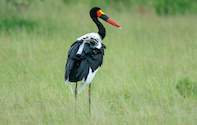
Kruger Park News Archive
Join the Endangered Wildlife Trust and SANParks in a photographic survey of Saddle-billed Storks in the Kruger National Park. The survey started on 1 September 2009 and will run for a full calendar year. This survey forms part of a research project that will be conducted over the next three years on the population status of Saddle-billed Storks, one of Kruger's rarities, and one of the "Big Six" birds.
"Census operations on any species within the boundaries of the Kruger National Park are important to help us get an idea of that species' status within the context of biodiversity management," says Marcelle van Hoven, the project's coordinator. "The last Saddlebilled Stork survey conducted in 1993 suggested that there were less than 60 of these birds left in the Park."
Saddle-billed Storks (Ephippiorhynchus senegalensis) are distinctly identifiable by their large size (they stand about 150 cm tall), sharply contrasting black and white plumage and yellow lappet (saddle-like structure) on the bill. The males have a dark eye with two small yellow wattles at the base of the bill, while females have a yellow eye. These birds can also be individually recognised by the details of the front edge of the black band across the red bill. Side-on photographs of all the birds, from both the left and right angles, will be used in identification during the survey.
Saddle-billed Storks are classified as Endangered in South Africa. They breed slowly and are dependant on extensive wetland habitats, which are under increasing pressure from humans. The flow regimes of rivers passing through the Kruger National Park are expected to change in response to catchment developments outside the Park, and this, together with the removal of artificial water impoundments within the Park, may have a negative impact on this species.
In South Africa, Saddle-billed Storks are largely confined to the north-eastern tropical lowland with the majority of the population residing along the riverine habitat in the Kruger National Park. They normally occur in pairs, are strongly territorial and remain in the same area for years.
Visitors who spot a Saddle-billed Stork are asked to take a clear photograph of both sides of the bird's face and bill and to record information about the sighting including the date, time, location, name of nearby water source, bird's gender, juveniles present and any other notes that might be relevant.
A Saddle-billed Stork census weekend is also planned in the Kruger National Park for later this year, where photographers with the powerful lenses can contribute to this project. Send all sighting details and photographs to storks@ewt.org.za.

 A Guide to Kruger Park birds and birding in Kruger National Park. Generally camps and waterholes are the best places for bird-watching and l...
A Guide to Kruger Park birds and birding in Kruger National Park. Generally camps and waterholes are the best places for bird-watching and l...